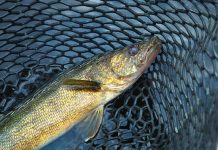If you choose to release your fish, there are several techniques that anglers should follow to increase the chances a fish will live to be caught again:
- Time is of the essence. Respect your catch, don’t overplay the fish. Play and release the fish as quickly and carefully as possible.
- Keep the fish in the water. Minimize or eliminate the time your fish is out of the water. As little as 30 seconds of air exposure can cause delayed mortality of released trout, and in the winter months the fish may be subject to a quick freeze.
- Wet your hands when handling the fish. Dry hands can remove the layer of slime that protects the fish from fungi, bacteria, and parasites.
- Photograph responsibly. Photo sessions can be stressful for a fish. Prepare for the photo with your fish safely under the water surface, and only lift the fish out of the water for 5-second intervals or less. Try to get the shot (within reason), but return your fish to the water for a rest between attempts.
- Be gentle. Keep your fingers away from the gills, don’t squeeze the fish, and please, never drag a fish onto the bank!
- Choose the right landing net. Rubber nets are easier on fish than traditional twine nets.
- Safely remove the hook with small pliers or a similar tool. If the hook is deeply embedded or in a sensitive area such as the gills or stomach, cut the leader close to the snout. Make an effort to use regular steel (bronzed) hooks to promote early disintegration. Avoid the use of stainless or gold-plated hooks. One way to release your fish quickly is to use barbless hooks. If barbed hooks are all you have, you can bend the barbs over or simply file them off.
- Revive the fish. Hold the fish underwater in a swimming position until it can swim away (note: do not use this method if surface water temperatures are unusually warm).
Anglers often set expectations of what they feel the perfect fishery looks like, it differs from one angler to the next, but one constant is a healthy fishery. Anglers taking ownership significantly helps in maintaining a healthy fishery – release a fish when the resource would be negatively affected or keep a fish when the resource requires a balance.
Ultimately, the fishing lawbook isn’t only telling you the laws, but it also is a guide anglers should use to know how best to maintain a healthy fishery. If you have a specific water in mind and want to make sure you’re a good steward, call a local biologist, we’re happy to talk fish with anglers about best practices for the resource!






